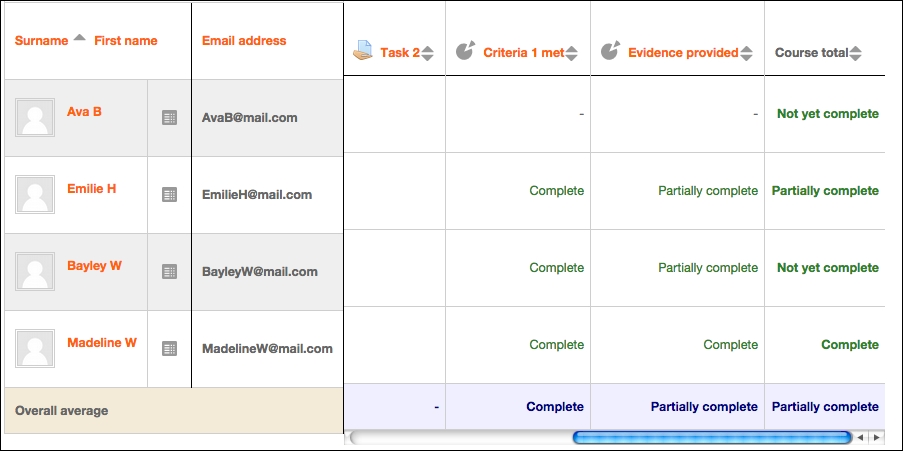We have seen a range of ways in which Moodle can use numbers, letters, and words to calculate the final course total. We will now look at how the outcomes we set in Chapter 2, Customizing Grades can be used in the course totals.
In this example, two assignment tasks have been set up with no grade but each has different outcomes applied to them. The outcomes are graded using the completion scale set up in Chapter 2, Customizing Grades.
When marking this work, only the outcomes are graded (as either Not yet complete, Partially complete, or Complete). We will need to tell the Gradebook to include outcomes in the grade aggregation.
For this example, students need to ensure that all the assignment outcomes are complete so a lowest grade aggregation will be used. This is useful as all outcomes need to be marked as complete for the course to be complete. If there is one Not yet complete or Partially complete grade, this will be shown as the course total and therefore, teachers and students will know that some work still needs to be completed. Once all outcomes are graded as complete, the lowest grade will be Complete and this will be shown in the Course total column. For these elements to be shown in the course total, the Course total grade type option needs to be the 'complete' scale. This process requires a running total based on all the required elements, so the aggregation must include nongraded (empty) items in the Gradebook.
There is one new element that needs to be applied here, in addition to settings we have previously used. In the following instructions, only the new step (that is, choosing to include the outcomes in the grade aggregation) will be explained. The other steps will be stated but you will need to use previously learned knowledge (or look back through previous pages) to apply them:
- Go to the Categories and items screen.
- Change the Aggregation type to Lowest grade.
- Click on the edit icon in the Actions column, then click on Show more in the Grade category section, and remove the tick in the box next to Aggregate only non-empty items. Also, click on the box to add a tick next to Include outcomes in aggregation.
- In the Category total section, ensure that the Grade type option is set to Scale and choose the Completion scale from the drop-down list.
- Make sure the Grade display type option is set to Real (we need to click on Show more to check this).
- Scroll to the bottom of the screen and click on Save changes.
- Then, switch to View the full Grader report.
When using outcomes, the Gradebook screen has a lot more information in it as each outcome is listed as an additional column on the screen. Using lots of outcomes can make the Gradebook a little difficult to use and will require some scrolling on your screen. However, you can see some of the items that have been graded and the course totals in the following screenshot:

No grade will be shown in the main assignment column (Task 2 in the previous example) as it has been set up with no grade, but it has two outcomes (shown with a circle icon) attached to it, which are are graded with a scale. While work is still being submitted and graded, the course total will remain Not yet complete. Once a grade has been awarded to all outcomes, the lowest grade will be the one that is shown as the course total option. Emilie H has submitted all her work and it has been graded, but there is still at least one element that is only partially completed, which is reflected in her course total. However, we can see that Madeline W has completed all her tasks, so her course total shows as Complete.
